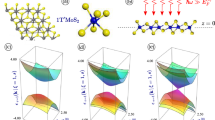Abstract
It is demonstrated theoretically that the interaction of gapped 2D materials (gapped graphene and transition metal dichalchogenide monolayers) with a strong high-frequency electromagnetic field (dressing field) crucially changes the band structure of the materials. As a consequence, the renormalized band structure of the materials drastically depends on the field polarization. Particularly, a linearly polarized dressing field always decreases band gaps, whereas a circularly polarized field breaks the equivalence of band valleys in different points of the Brillouin zone and can both increase and decrease corresponding band gaps. It is shown also that a dressing field can turn both the band gaps and the spin splitting of the bands into zero. As a result, the dressing field can serve as an effective tool to control spin and valley properties of the materials in various optoelectronic applications.
Similar content being viewed by others
References
P. Hanngi, in Quantum Transport and Dissipation, Ed. by T. Dittrich, P. Hanggi, G.-L. Ingold, B. Kramer, G. Schon, and W. Zwerger (Wiley, Weinheim, 1998), p. 249.
S. Morina, O. V. Kibis, A. A. Pervishko, and I. A. Shelykh, Phys. Rev. B 91, 155312 (2015).
A. A. Pervishko, O. V. Kibis, S. Morina, and I. A. Shelykh, Phys. Rev. B 92, 205403 (2015).
K. Dini, O. V. Kibis, and I. A. Shelykh, Phys. Rev. B 93, 235411 (2016).
K. Kristinsson, O. V. Kibis, S. Morina, and I. A. Shelykh, Sci. Rep. 6, 20082 (2016).
O. V. Kibis, S. Morina, K. Dini, and I. A. Shelykh, Phys. Rev. B 93, 115420 (2016).
O. V. Kibis, K. Dini, I. V. Iorsh, and I. A. Shelykh, Phys. Rev. 95, 125401 (2017).
A. C. Ferrari et al., Nanoscale 7, 4598 (2015).
A. Kormanyos et al., 2D Mater. 2, 022001 (2015).
D. A. Romanov and O. V. Kibis, Phys. Lett. A 178, 335 (1993).
O. V. Kibis, JETP Lett. 66, 588 (1997).
O. V. Kibis, Phys. Lett. A 237, 292 (1998).
O. V. Kibis, Phys. Lett. A 244, 432 (1998).
D. Lawton, A. Nogaret, M. V. Makarenko, O. V. Kibis, S. J. Bending, and M. Henini, Physica E 13, 699 (2002).
Author information
Authors and Affiliations
Corresponding author
Additional information
The article is published in the original.
Rights and permissions
About this article
Cite this article
Kibis, O.V., Dini, K., Iorsh, I.V. et al. Floquet Engineering of Gapped 2D Materials. Semiconductors 52, 523–525 (2018). https://doi.org/10.1134/S1063782618040176
Received:
Published:
Issue Date:
DOI: https://doi.org/10.1134/S1063782618040176




